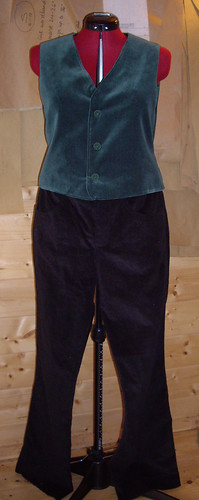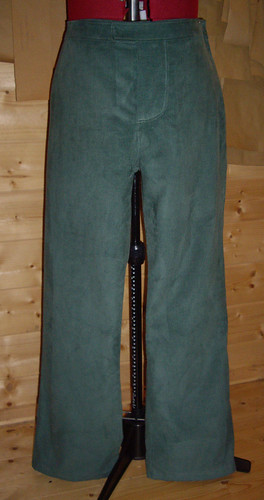This weekend I’ve been sewing the waistcoat to go with the Dorset buttons I made last Sunday. The pattern is McCalls 8285, and the fabric is a sage green cotton velvet. It’s almost finished – I just need to make the buttonholes, and sew a little silver buckle onto one of the straps at the back.
The trousers I actually made a few weeks ago. I didn’t photograph them because as soon as they were finished I put them on, and I’ve been wearing them (or washing them) ever since! They’re another pair of Vogue 1034, this time in black needlecord with a bit of a stretch to it. The pockets and waistband are lined with the remnants of the Sea of Holes fabric – just so I could feel amused by having pockets full of holes. (Yes yes, groan, I know.)
The trouble with wearing both cord and velvet is that they both act a bit like velcro when it comes to fluff. The cords accidentally went through the washing machine with a stray tissue which left them all white and fuzzy, and now they’re covered in green dandruff from cutting the velvet.
This outfit is two-thirds of what I’ll be wearing when I go out playing the recorder with the clog dancers. I now have just less than three weeks to either make or buy a shirt with long sleeves and no collar. I’ve got miles of white polycotton that’s suitable for shirting, and two patterns that would be fine. One is Folkwear 117 that I’ve made before, and the other is McCalls 5976. It just remains to be seen whether I’ll have time to make one of them, or whether I’ll need to dash down to the shops. Thankfully pintucked shirts seem to be in fashion at the moment, so hopefully I won’t have too much trouble finding one that’s suitable.
Three weeks until my first recorder-playing performance in about eighteen years. Gosh.


